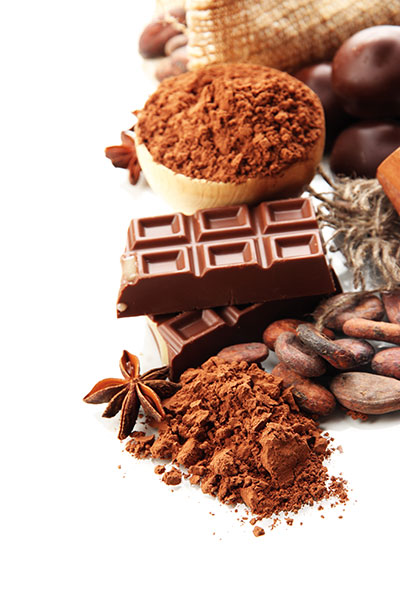
Chocolate insights
June 4, 2013
By Kristi Gogan
Customers can be a complex bunch, but a trip to San Francisco shed light
on the top five things my clients are going to want from my chocolate
business and more.
Customers can be a complex bunch, but a trip to San Francisco shed light on the top five things my clients are going to want from my chocolate business and more. I joined 60 graduates, students and staff from Ecole Chocolat at the Intercontinental Hotel in San Francisco to celebrate the school’s 10th anniversary. “All That Jazz: The Future of Flavor, Texture and Presentation in Bonbon and Bars” was the theme. Four well-established chocolatiers gave us their forecast on the future of chocolate. Philippe Givre of Valrhona L’Ecole du Grand Chocolat in France reminded us that every market is different. He briefly described three global markets. The American market tends to go a little more on the bold side with lots of colour, the European market prefers simple designs with some colour and the Asian market does not care for much colour.

|
|
Paul DeBondt of DeBondt Cioccolato Originale in Italy shared his passion for creating his own treats using more than 50 different types of chocolate and cocoa mass. He spoke about the importance of constructing our bonbons and bars so that the chocolate stands out. He presented an air-filled truffle he made especially for the Ecole group that represented the construction process of flavour from the first bite to the last. When I allowed this truffle to melt in my mouth, I experienced a flavour explosion that accented the chocolate flavour with a rose flavour in the airy centre. The flavours were harmonious.
The top five trends influencing the future of fine chocolate
Here’s a rundown of five key things to keep in mind for your chocolate operation, as well as advice from cutting edge chocolatiers.
Quality and flavour: More and more, chocolatiers are choosing the highest quality of chocolate and ingredients that produce the finest flavour. Know where the ingredients come from and how they are produced and manufactured. Have a good recipe for each creation: one that has a relatively good shelf life so it has the same taste sensation on Day 1 as on Day 21. Control and respect the ingredients, the way you use them and how they combine with the chocolate. It’s important to decide on the right technique for the right flavour combination. The chocolate’s flavour needs to be the number 1 taste. It is important not to overpower the taste of the chocolate itself.
Balance of flavour: Bonbon recipes need to have harmony and logic in their creation. Bart van Cauwenberghe of Dezwartevos Artisanal Chocolates in Belgium spoke about how there is a Chinese restaurant in every town. Why? Because they are masters in the art of balancing sweet and sour as well as textures. Knowing the ingredients you are working with will help you choose those that will harmonize perfectly with the chocolate you are using. If you choose hot peppers, for instance, there are thousands of varieties worldwide. Knowing flavour profiles of the individual varieties and where they are grown will help you decide which ones will synchronize perfectly. The magic of creating a recipe is in the layers of flavour. We taste soft ingredients first (such as ganache or butter) and hard ingredients last (such as nuts or hard candy). The bonbon needs to be constructed so that it will burst with flavour from beginning to end.
Having a fingerprint: We need to be aware of what it means to be artisan chocolatiers.
Dictionary.com defines artisan as:
“1. a person skilled in an applied art; a craftsperson.
2. a person or company that makes a high-quality or distinctive product in small quantities, usually by hand or using traditional methods.”
Artisans have a fingerprint that is presented through their design, style and recipes. The chocolatier’s product is recognizable by the presentation
and packaging.
Local, fresh and seasonal: Consumers love to hear that something is made from fresh, local ingredients. They want to hear the story behind the creation – that the mint was picked from the garden that morning or that the farmer down the road grows the berries you use. Pick flavours from ingredients that are in season at the time. People also love to watch a product being made. The upside to this is they see how much work is involved in creating that perfect bonbon they are paying good money for. They know they are getting a high-quality, fresh and fine-flavoured bonbon or bar.
Traditional and daring: The nostalgia movement is still strong. Traditional flavours will always be tried and true but once in a while someone wants to come out of their comfort zone and try something new. A bold flavour such as Gail Ambrosius’ shitake mushroom truffle or my lemongrass/coconut bonbon brings the people in the door. They may not always choose the most exotic flavours, but it will always intrigue them to see what’s inside.
Kristi Gogan is a certified chocolatier through Ecole Chocolat, and worked as a certified cook for 15 years in restaurants, resorts and even the Canadian Forces before establishing Sweet Odyssey Chocolatier.
Print this page
Leave a Reply